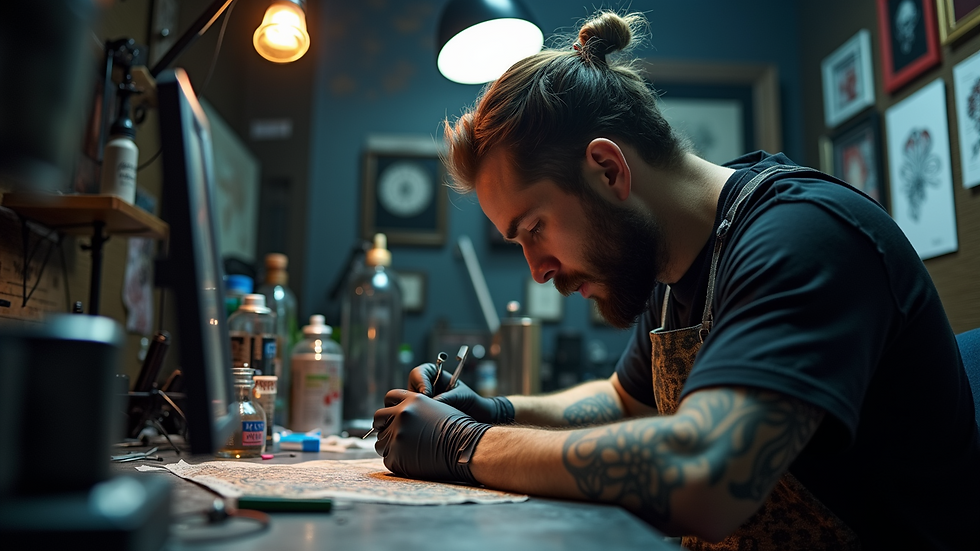Understanding Tattoos: A Deep Dive into Art, Culture, and Meaning
- Limitless Tattoo
- Oct 9
- 4 min read
Tattoos have captivated humans for thousands of years. They are more than just ink on skin; they are powerful symbols of expression, identity, and art. From tribal markings of ancient times to modern intricate designs, tattoos tell stories that resonate across cultures. This article explores the significance of tattoos, their cultural contexts, and the artistry behind them.
The History of Tattoos
Tattoos boast a fascinating history that stretches back to ancient civilizations. The earliest known tattoos were found on Ötzi the Iceman, whose remains date back to around 3300 BC. He had 61 tattoos on his body, which researchers believe could have been used for therapeutic purposes.
Different cultures have embraced tattooing for various reasons. In Polynesian culture, tattoos signify social status and personal achievements. For instance, Samoan tattoos often depict family lineage and accomplishments, and receiving them is a significant event. In Japan, tattoos are closely linked to the Yakuza, where elaborate designs symbolize strength and loyalty. This cultural diversity illustrates how tattoo art varies dramatically around the world.
The Art of Tattooing
Tattooing is a unique art form that combines skill, creativity, and precision. Tattoo artists dedicate years to perfecting their craft, learning various techniques and styles while understanding the nuances of tattoo placement on the body.
There are numerous tattoo styles, each with distinct characteristics. Traditional tattoos, often featuring bold lines and vivid colors, appeal to those seeking classic designs. Realism, on the other hand, focuses on lifelike representations, with detailed shading and colors creating stunning images that can resemble photographs. This variety energizes the tattoo community, allowing individuals to find a style that resonates with their personal narrative.
The Importance of Tattoos
Tattoos extend beyond aesthetics; they are vital avenues of self-expression. Many individuals choose tattoos to celebrate their beliefs, experiences, or emotions. For example, someone might get a tattoo of a significant date or quote to commemorate overcoming a challenge.
Tattoos can also forge connections. Many people opt for matching tattoos with friends or family to symbolize their bond. This shared experience can bring communities closer, especially in cultures where tattoos serve as rites of passage, marking the transition from adolescence to adulthood.
Cultural Significance
The meaning of tattoos varies widely across cultures. In some communities, tattoos are seen as marks of beauty and strength, while, in others, they may carry stigma. In the West, tattoos have gained mainstream acceptance, with surveys indicating that nearly 40% of millennials have at least one tattoo. This acceptance reflects the evolving perception of tattoos as forms of art rather than mere adornments.
Conversely, in more conservative societies, tattoos might still face scrutiny. Understanding these cultural nuances is crucial for appreciating the social dynamics surrounding tattooing. It's essential to approach the art with respect for its origins, particularly when exploring designs from cultures outside one's own.
The Process of Getting a Tattoo
Getting a tattoo is not merely a spur-of-the-moment decision; it involves thoughtful consideration. The journey usually starts with selecting a design and finding a reputable tattoo artist. Researching artists and their previous work is critical to ensure the chosen style matches one's vision.
Once the design is finalized, the tattoo artist prepares the client’s skin and begins the tattooing process. Depending on the complexity, this can take anywhere from a few minutes to several hours. Aftercare is crucial post-tattoo. Proper cleaning and moisturizing help the tattoo heal correctly, preserving its vibrancy for years to come.
Tattoos in Modern Society
Today, tattoos have become increasingly popular across various demographics, particularly among travelers and photographers. Many people use tattoos to document their journeys, creating visual memories that capture the essence of their experiences. Travel-themed tattoos, such as compass designs or coordinates of significant locations, are particularly popular.
For photographers, tattoos offer unique subjects for artistic expression. Capturing intricate tattoo details can result in stunning visuals, showcasing the artistry inherent in tattooing and photography alike. This merging of art forms highlights the deep connections people have with their tattoos.
The Future of Tattooing
As society evolves, so does tattooing. Emerging technologies enhance design intricacy and improve safety practices. The stigma surrounding tattoos is lessening, with a growing number of professionals in various fields embracing body art.
Looking forward, sustainability in tattooing is becoming paramount. More artists are adopting eco-friendly inks and materials, driven by increasing awareness of environmental issues. This shift not only helps the planet but also attracts a more eco-conscious clientele.
Final Thoughts
Tattoos blend art, culture, and personal expression in a compelling manner. They carry deep meanings and stories that resonate with diverse individuals around the world. Understanding the significance of tattoos and their cultural context enriches our appreciation of this ancient art form.
As tattooing continues to evolve, it remains a vibrant aspect of human expression. Whether you are a traveler, photographer, or someone simply intrigued by tattoo art, there is an expansive world waiting to be explored and appreciated.









Comments